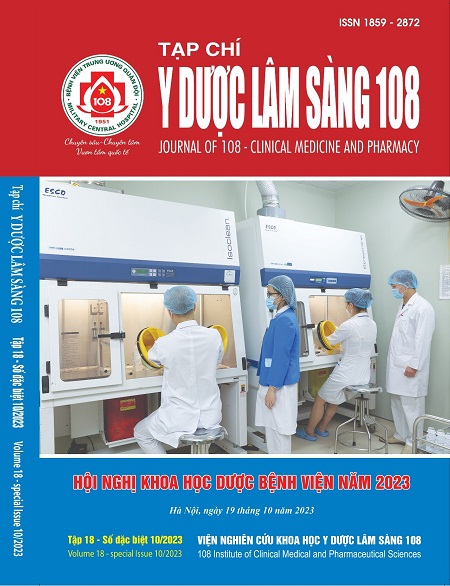Antibiotic use in patients with renal impairment at University Medical Center Ho Chi Minh City
Main Article Content
Keywords
Abstract
Objective: To investigate antibiotic usage, appropriateness of dosing regimens, treatment outcomes, and renal toxicity related to antibiotic use among patients with renal impairment at University Medical Center Ho Chi Minh City (UMC HCMC). Subject and method: A descriptive cross-sectional study was performed on 372 patients diagnosed with renal impairment and indicated with at least one renally excreted antibiotic at UMC HCMC between 03/2021 and 12/2021. Appropriateness of dosing regimens was evaluated using the manufacturer’s instruction, Uptodate 2021, Sanford Guide 2021. Result: The median age of the study population was 77 (67-85) and female accounted for 57.0%. Beta-lactam (84.4%) and fluoroquinolone (41.4%) were the most commonly indicated classes of antibiotic. The proportion of appropriate dosing after adjustment was 66.1%. Male (OR: 4.308, 95%CI: 1.168-15.884, p=0.028), obesity (OR: 4.308, 95%CI: 1.168-15.884, p=0.028), indication of fosfomycin (OR: 0.187, 95%CI: 0.075-0.466, p<0.001), and indication of glycopeptide class (OR: 0.387, 95%CI: 0.205-0.730, p=0.003) were statistically associated with appropriate dosing of antibiotics. Successful treatment outcomes were observed in 86.6% of the study population and the incidence of renal toxicity was 7.5%. Conclusion: Results from the study suggests the need of enhancing dosing adjustment of antibiotics among patients with renal impairment in clinical settings.
Article Details
References
2. Long CL, Raebel MA, Price DW et al (2004) Compliance with dosing guidelines in patients with chronic kidney disease. Annals of Pharmacotherapy 38(5): 853-858.
3. Prajapati A, Ganguly B (2013) Appropriateness of drug dose and frequency in patients with renal dysfunction in a tertiary care hospital: A cross-sectional study. Journal of pharmacy & bioallied sciences 5(2): 136-140.
4. Chahine B (2021) Antibiotic dosing adjustments in hospitalized patients with chronic kidney disease: a retrospective chart review. Int Urol Nephrol, 54(1): 157-163.
5. Lưu Quang Huy, Nguyễn Mai Hoa, Cẩn Tuyết Nga và cộng sự (2018) Đặc điểm hiệu chỉnh liều kháng sinh cho bệnh nhân suy thận tại Bệnh viện Bạch Mai. Tạp chí Y học lâm sàng (101), tr. 97-104.
6. Onyango MA, Okalebo FA, Nyamu DG et al (2014), Determinants of Appropriate Antibiotic Dosing in Patients with Chronic Kidney Disease in a Kenyan Referral Hospital. African Journal of Pharmacology and Therapeutics. 3(1): 19-28.
7. Vondracek SF, Teitelbaum I, Kiser TH (2021) Principles of kidney pharmacotherapy for the nephrologist: Core curriculum 2021. American Journal of Kidney Diseases 78(3) :442-458.
8. Filippone EJ, Kraft WK, Farber JL (2017) The nephrotoxicity of vancomycin. Clinical Pharmacology Therapeutics 102(3): 459-469.
9. Tuon FF, Rigatto MH, Lopes CK et al (2014) Risk factors for acute kidney injury in patients treated with polymyxin B or colistin methanesulfonate sodium. International journal of antimicrobial agents 43(4): 349-352.
 ISSN: 1859 - 2872
ISSN: 1859 - 2872
